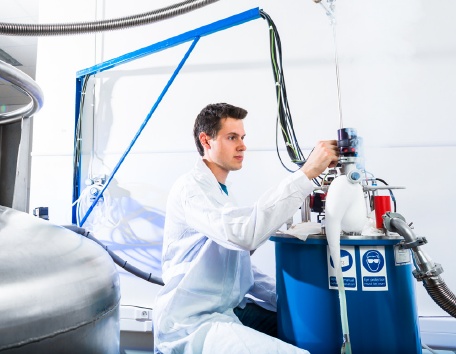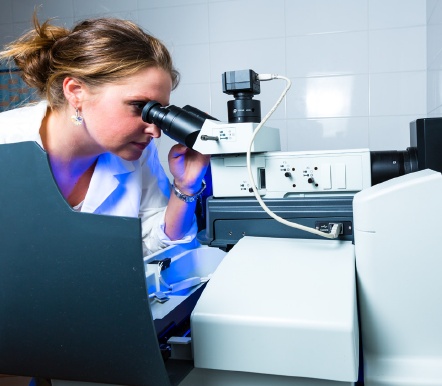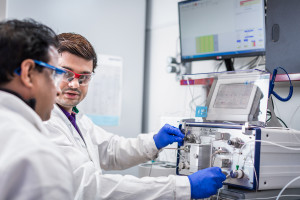
Magnetic Nanostructures
Group Leader: Aristeides Bakandritsos, Ph.D.
The group focuses on the synthesis, development and study of low‑dimensional materials based on carbon, iron, nonhydrated iron oxides and their hybrids, including molecular complexes. Significant attention is devoted to understanding the mechanisms driving the structure and composition of these materials in relation to their magnetic features, along with engineering their reactive and functional sites, describing their behaviour in the nanoworld and identifying such parameters that can tune their properties and enhance their applicability. The application potential ranges from technological to catalytic to environmental remediation and applications related to energy storage. For in‑depth structural and magnetic characterization, a broad portfolio of experimental techniques is employed, including Mössbauer spectroscopy in various modes (low-, room-, and high-temperature or in-field), magnetometers (PPMS-DC/AC) and EPR spectroscopy. When studying materials for energy storage, the group exploits electrochemical battery stations with environmental chambers and glove-boxes. The group also operates instruments for TG and DSC analyses coupled with evolved gas analysis with mass spectroscopy. The activities further involve simulation and theoretical modelling to describe the magnetic properties of carbon nanostructures in particular. The group has also access to the central infrastructure of RCPTM for advanced materials characterization. Besides conducting research, the group participates in the development and construction of Mössbauer spectrometers, which are sold worldwide, and in the production of new brands of permanent magnets based on rare iron oxides phases.
More about the group

Carbon Nanostructures, Biomolecules and Simulations
Group Leader: Prof. RNDr. Michal Otyepka, Ph.D.
The research focus includes synthesis, characterization and applications of low-dimensional carbon-based materials (especially carbon dots, graphene and its derivatives). Researchers develop new methods for the functionalization and chemical modification of graphene and its derivatives. A deep understanding of physicochemical properties helps them design functional materials, with the aim of using them especially in catalysis, energy storage, sensing and imaging. Scientists’ efforts are underpinned by the close interconnection of experimental and theoretical approaches. Their knowledge in computing chemistry ranges from the first basic methods, to multiple techniques, to the development of a force field. This allows molecular simulations to be applied to a wide range of molecular structures containing nanomaterials, biomacromolecules and complex molecular systems.
More about group

Biologically Active Complexes and Molecular Magnets
Group Leader: Prof. RNDr. Zdeněk Trávníček, Ph.D.
The group focuses on novel complex compounds of transitional elements, particularly on the development of novel types of biologically active compounds with medical application potential (e.g. substances with tumour-fighting, anti-inflammatory or antidiabetic effects), the preparation and study of molecular magnets and molecular switches which may be used, e.g. for sensors, high density memory or recording media, research on hybrid molecular-crystalline nanostructures with functionalized nanocrystalline iron oxides bound to a coordination compound.
More about the group

Nanomaterials in Biomedicine
Group Leader: Mgr. Kateřina Poláková, Ph.D.
The research of the group Bio-Med is aimed on two overlapping fields: synthesis of novel nanomaterials and their consecutive application in biological and medicinal branches. Synthetic part of the group has a long time history in a design and synthesis of nanomaterials based on metals (iron, silver, gold, platinum) or their respective oxides. The resulting form of nanomaterials includes nanocomposites, nanoalloys as well as core-shell structures. Our infrastructure allows a characterization of nanomaterials using microscopic techniques as well as a study of interactions of selected nanomaterials with living systems on cellular level and on animals. Application part of the group specializes in a development of diverse analytical procedures applicable in medicinal diagnostics, environmental chemistry or toxicology or design of novel contrast agents applicable in MRI.
More about the group
 Environmental Nanotechnologies
Environmental Nanotechnologies
Group Leader: Mgr. Jan Filip, Ph.D.
The main emphasis of the “Environmental Nanogroups” at RCPTM has been the design and development of advanced nanomaterials and technologies for the applications in environmental chemistry including sustainable applications in catalysis. Presently, our group is working on three major areas: 1) Earth-abundant materials for environmental applications, 2) benign catalytic applications and 3) photo- and electrochemical applications. The first area encompasses the development of iron-based species (namely zero-valent iron, ferrates etc.), for the environmental applications including water purification by removal of toxic materials, investigation of ecotoxicity of metal-based nanoparticles etc. The second area focusses on the catalytic applications of metal, metal-oxide, carbon-based nanomaterials for important organic transformations. In this category, our progress in the field of iron-oxide supported catalytic systems offers unique advantages of high recyclability and magnetic separations, thereby making such processes more environmentally friendly as well as economical. In addition, our recently installed state-of-the-art microwave and “Flow reactor” also contributes significantly in enhancing the productivity of the group. Finally, the recent upsurge in the field of photo- and electro-chemistry particularly for their energy-related applications including solar cells, electrocatalysis etc. have also prompted us to be a part of this endeavor and we have been engaged in developing novel materials to be applied in photo- and electrochemical applications.
More about the group
Photoelectrochemistry
Group Leader: Prof. Patrik Schmuki
The Photoelectrochemical group aims at developing a new class of multicomponent hybrid systems (HNS) composed of a central material (CS), most likely metal oxides semiconductors (TiO2, α-Fe2O3, ZnO, WO3, BiVO4, etc.) and carbon based materials with controlled shape and dimensionality (e.g., 1D-nanotubes, 2D-ultrathin films, 3D branched nanoarchitectures, etc.) that will work as highly photocatalytically and electrocatalytically active materials for a broad portfolio of energy and environmental applications including direct splitting of water, photocatalysis, electrocatalysis, dye sensitized solar cells, etc.. The key-approach is represented by the simultaneous and synergistic combination of strategies (nanostructuring, co-catalyst deposition, surface sensitization) that are still very often studied and developed independently. Therefore, the nanostructured CMs are coupled to counterparts with specific functionalities (extended visible light absorption, remarkable efficiency in charge transfer, enhanced carrier mobility) and the effective interaction of the single components will significantly benefit the PEC efficiency of the composite system. The group is very well equipped for a thorough electrochemical, photoelectrochemical, and photocatalytic investigation of the materials and hybrid nanostructures developed.
More about the group


